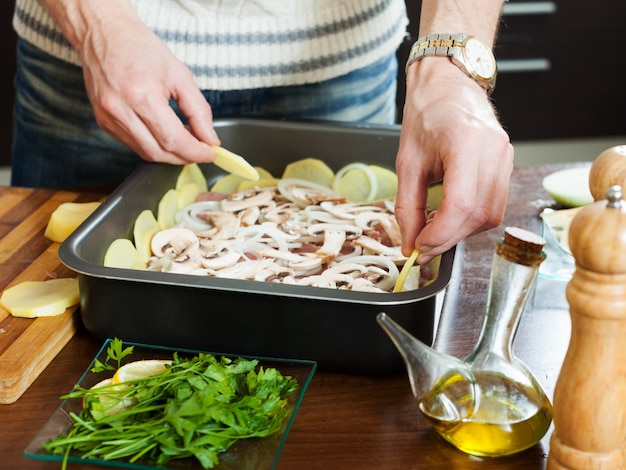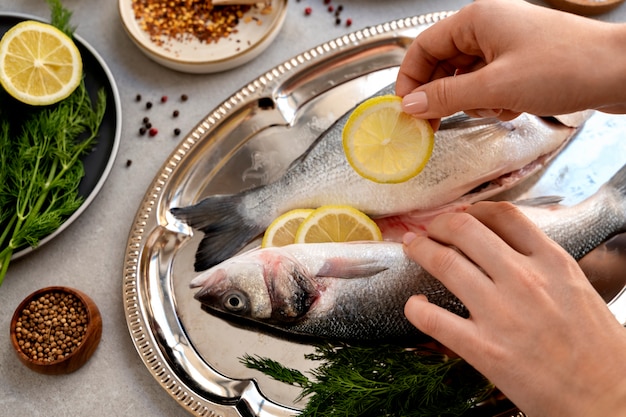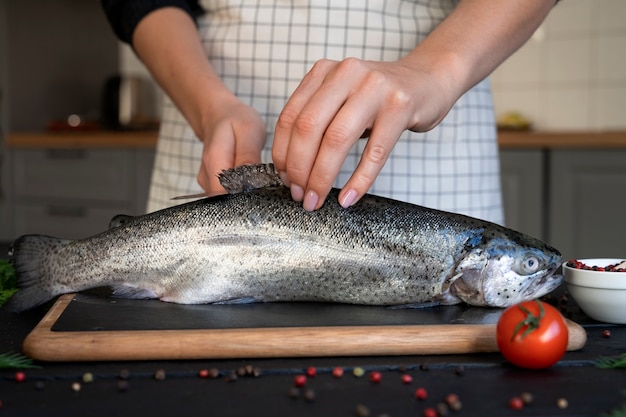I've always been a big fan of halibut. There's something about its delicate, flaky texture and mild flavour that just calls to me. But for a long time, I struggled with cooking it. It seemed like every time I tried to bake it, it would turn out dry or tough. Then, I finally figured out the secret: oven-baking is the way to go! It's the perfect method for getting that delicious, golden-brown crust and melt-in-your-mouth texture. And once you've mastered it, you'll be whipping up halibut feasts left, right, and centre.
In this article, we're going to explore some easy, foolproof recipes that will have you wowing your friends and family in no time. I'll be sharing my personal tips and tricks, along with some of my favourite flavour combinations. And don't worry if you're a beginner in the kitchen, these recipes are so simple even a toddler could manage them (well, maybe not the toddler, but you get the idea).
Part 1: Choosing Your Halibut

What to Look For
Firstly, let's talk about the star of the show: the halibut. I always recommend going for the freshest piece you can find, ideally from a reputable fishmonger. Here's what you should look for:
- Bright, Clear Eyes: Fresh halibut will have eyes that are clear and slightly bulging, not cloudy or sunken.
- Firm Flesh: The flesh should be firm to the touch and spring back when pressed. If it feels soft or mushy, it's not fresh.
- Slightly Sweet, Clean Scent: Fresh halibut should have a mild, slightly sweet scent, reminiscent of the sea. Avoid any fish that has a fishy or ammonia-like smell, as this indicates it's not fresh.
Types of Halibut
There are two main types of halibut: Atlantic and Pacific. Here's a quick rundown:
| Type | Characteristics |
|---|---|
| Atlantic Halibut | Larger in size, firmer texture, slightly stronger flavour. |
| Pacific Halibut | Smaller in size, milder flavour, slightly softer texture. |
Personally, I usually just go with whatever's freshest at the market. Both types are delicious in their own right, so just choose whichever you prefer.
Size and Thickness
The size and thickness of your halibut will determine how long it needs to bake. A thinner fillet will cook faster than a thick steak. Generally, aim for fillets that are about 1-2 inches thick. If you have a thicker steak, you may need to increase the baking time. But don't worry, I'll give you all the details on how to judge when it's done.
Part 2: Preparing Your Halibut

Skin On or Skin Off?
This is a question that's divided many a fish fan. Some people prefer to leave the skin on, saying it adds flavour and keeps the flesh moist. Others find it easier to bake skinless fillets, and that's totally fine too. Personally, I prefer to remove the skin, mainly because I find it a bit chewy. But it's all down to personal preference!
Scoring the Fish
Now, here's a little trick I've learned: scoring your halibut. This involves making shallow cuts across the flesh, which helps to create a more even cook and allows flavours to penetrate deeper. Just use a sharp knife and make cuts about a half-inch apart. Don't go too deep, though, you just want to make some neat little grooves. Think of it like a little fish massage to help it cook evenly.
Salt and Pepper
Before we move on to the recipes, there's one essential step: seasoning. Now, you can go all fancy and use a blend of herbs and spices, but I find that simple salt and pepper really lets the flavour of the halibut shine through. Season generously on both sides, but be careful not to overdo it. You don't want your fish to be salty. A sprinkle of salt and pepper is all it takes to bring out the natural flavour of the halibut.
Part 3: The Classic Lemon and Herb Bake

Okay, let's start with a recipe that's both simple and delicious. This is a true classic, and it never fails to impress. It's a beautiful and refreshing dish that's perfect for any occasion.
Ingredients
- 1 (1-2 pound) halibut fillet, skin removed
- 1 tablespoon olive oil
- 1 lemon, thinly sliced
- 2 cloves garlic, minced
- 1/4 cup fresh parsley, chopped
- 1/4 cup dry white wine (optional)
- Salt and freshly ground black pepper, to taste
Instructions
- Preheat oven to 400 degrees Fahrenheit (200 degrees Celsius).
- Grease a baking sheet or use parchment paper for easy cleanup.
- Place the halibut fillet on the prepared baking sheet and brush with olive oil.
- Arrange the lemon slices over the halibut, then sprinkle with minced garlic and chopped parsley.
- Season with salt and pepper to taste.
- If using white wine, pour it over the fish and lemon slices.
- Bake for 15-20 minutes, or until the fish is cooked through and flakes easily with a fork.
- Remove from the oven and let rest for a few minutes before serving.
Tips and Variations
- If you prefer a more intense lemon flavour, you can add a squeeze of lemon juice to the olive oil before brushing it on the halibut.
- For a more herbaceous flavour, use a mix of fresh herbs like thyme, rosemary, or dill.
- You can also add a pinch of red pepper flakes for a bit of heat.
- Serve this dish with a side of roasted vegetables, like asparagus or broccoli, or a simple green salad.
Part 4: Roasted Halibut with Cherry Tomatoes and Basil
Looking for a recipe that's bursting with flavour and colour? Look no further! This dish is perfect for a summer dinner party, and it's surprisingly easy to make. The combination of sweet cherry tomatoes, fragrant basil, and delicate halibut is a taste sensation.
Ingredients
- 1 (1-2 pound) halibut fillet, skin removed
- 2 tablespoons olive oil
- 1 pint cherry tomatoes, halved
- 1/4 cup fresh basil leaves, chopped
- 1 clove garlic, minced
- Salt and freshly ground black pepper, to taste
Instructions
- Preheat oven to 400 degrees Fahrenheit (200 degrees Celsius).
- Grease a baking sheet or use parchment paper.
- Place the halibut fillet on the prepared baking sheet and brush with olive oil.
- In a bowl, toss the cherry tomatoes with the remaining olive oil, basil leaves, and minced garlic. Season with salt and pepper.
- Spread the tomato mixture around the halibut fillet.
- Bake for 15-20 minutes, or until the fish is cooked through and the tomatoes are softened.
- Remove from the oven and let rest for a few minutes before serving.
Tips and Variations
- For a more intense tomato flavour, you can roast the cherry tomatoes before adding them to the halibut. Simply spread them on a baking sheet and roast at 400 degrees Fahrenheit for about 15 minutes, or until they start to soften.
- You can also add other vegetables to the dish, such as zucchini, bell peppers, or asparagus.
- Serve this dish with a side of crusty bread to soak up the delicious juices.
Part 5: Creamy Herb-Crusted Halibut with Roasted Vegetables
Okay, let's get fancy with this one! This recipe features a delightful herb crust that adds a layer of flavour and texture to the halibut. And the roasted vegetables are the perfect accompaniment. This is a showstopper, I tell you! The creamy herb crust adds a touch of elegance to the dish, and the roasted vegetables provide a beautiful medley of textures and flavours.
Ingredients
- 1 (1-2 pound) halibut fillet, skin removed
- 1/2 cup panko breadcrumbs
- 1/4 cup grated Parmesan cheese
- 2 tablespoons chopped fresh parsley
- 1 tablespoon chopped fresh thyme
- 1 tablespoon olive oil
- 1/4 teaspoon salt
- 1/4 teaspoon freshly ground black pepper
- 1 cup mixed vegetables (such as broccoli, carrots, zucchini, and onions), chopped
- 2 tablespoons olive oil
- Salt and freshly ground black pepper, to taste
Instructions
- Preheat oven to 400 degrees Fahrenheit (200 degrees Celsius).
- Grease a baking sheet or use parchment paper.
- In a medium bowl, combine the panko breadcrumbs, Parmesan cheese, parsley, thyme, olive oil, salt, and pepper.
- Place the halibut fillet on the prepared baking sheet and brush with olive oil.
- Spread the herb mixture evenly over the halibut fillet.
- In a separate bowl, toss the vegetables with the remaining olive oil, salt, and pepper.
- Spread the vegetables around the halibut fillet.
- Bake for 20-25 minutes, or until the fish is cooked through and the vegetables are tender.
- Remove from the oven and let rest for a few minutes before serving.
Tips and Variations
- You can experiment with different herbs and spices in the breadcrumb mixture, such as rosemary, oregano, or garlic powder.
- If you want to add a bit of sweetness to the dish, you can drizzle a tablespoon of honey or maple syrup over the halibut before baking.
- You can also add other vegetables to the dish, such as Brussels sprouts, potatoes, or sweet potatoes.
- This recipe is perfect for a special occasion, and it's sure to impress your guests.
Part 6: Baked Halibut with Dijon Mustard and Herbs
This recipe is all about simple, bold flavours. The Dijon mustard adds a tangy kick, while the herbs provide a fresh, aromatic touch. This is a quick and easy meal that's perfect for a busy weeknight. It's a flavourful and satisfying dish that's ready in under 30 minutes.
Ingredients
- 1 (1-2 pound) halibut fillet, skin removed
- 1 tablespoon olive oil
- 1 tablespoon Dijon mustard
- 1 tablespoon chopped fresh parsley
- 1 tablespoon chopped fresh dill
- 1/2 teaspoon salt
- 1/4 teaspoon freshly ground black pepper
Instructions
- Preheat oven to 400 degrees Fahrenheit (200 degrees Celsius).
- Grease a baking sheet or use parchment paper.
- In a small bowl, combine the olive oil, Dijon mustard, parsley, dill, salt, and pepper.
- Place the halibut fillet on the prepared baking sheet and brush with the mustard mixture.
- Bake for 15-20 minutes, or until the fish is cooked through.
- Remove from the oven and let rest for a few minutes before serving.
Tips and Variations
- You can substitute the Dijon mustard with another type of mustard, such as honey mustard or stone ground mustard.
- For a spicier flavour, add a pinch of red pepper flakes to the mustard mixture.
- Serve the halibut with a side of roasted vegetables or a simple salad.
Part 7: Baked Halibut with Roasted Garlic and Lemon
This recipe combines the classic flavours of garlic and lemon with the richness of halibut. The roasted garlic adds a sweet and mellow flavour, while the lemon brightens the dish and cuts through the richness of the fish. It's truly a heavenly combination! The roasted garlic adds a depth of flavour that's both savory and slightly sweet, while the lemon provides a refreshing acidity that balances the richness of the fish.
Ingredients
- 1 (1-2 pound) halibut fillet, skin removed
- 1 head of garlic, halved lengthwise
- 1 lemon, thinly sliced
- 2 tablespoons olive oil
- 1/2 teaspoon salt
- 1/4 teaspoon freshly ground black pepper
Instructions
- Preheat oven to 400 degrees Fahrenheit (200 degrees Celsius).
- Grease a baking sheet or use parchment paper.
- Place the halibut fillet on the prepared baking sheet.
- Arrange the garlic halves and lemon slices around the halibut fillet.
- Drizzle the olive oil over the halibut, garlic, and lemon.
- Season with salt and pepper.
- Bake for 15-20 minutes, or until the fish is cooked through and the garlic is softened.
- Remove from the oven and let rest for a few minutes before serving.
- Squeeze the roasted garlic cloves over the halibut before serving.
Tips and Variations
- For a more intense garlic flavour, you can roast the garlic cloves separately. Simply place them on a baking sheet and roast at 400 degrees Fahrenheit for about 20 minutes, or until they are soft and golden brown.
- You can also add other aromatics to the dish, such as rosemary, thyme, or oregano.
- Serve the halibut with a side of roasted vegetables or a simple salad.
Part 8: Tips for Perfect Oven-Baked Halibut
Now that you've got some delicious recipes under your belt, let's talk about some general tips for baking halibut to perfection. These tips will help you achieve consistently delicious results every time you bake halibut.
Don't Overcook It
Halibut is a delicate fish, so it's important not to overcook it. Overcooked halibut will be dry and tough. The best way to tell if it's done is to use a meat thermometer. The internal temperature should reach 145 degrees Fahrenheit (63 degrees Celsius). If you don't have a meat thermometer, you can gently press on the fish with a fork. If it flakes easily, it's done. If it's still firm, it needs to cook a bit longer.
Rest Before Serving
Once the halibut is cooked, let it rest for a few minutes before serving. This allows the juices to redistribute, resulting in a more tender and flavorful fish.
Serving Suggestions
Halibut is a versatile fish that can be served with a variety of sides. Here are a few of my favourites:
- Roasted vegetables (such as asparagus, broccoli, carrots, or zucchini)
- Green salad with a light vinaigrette
- Rice or quinoa
- Pasta with a simple sauce
- mashed potatoes
Part 9: FAQs about Oven-Baked Halibut
What is the best way to store halibut?
Fresh halibut should be stored in the refrigerator, wrapped tightly in plastic wrap or aluminum foil. It can be stored for up to 2 days. If you're not going to use it within a couple of days, you can freeze it for up to 3 months. To freeze, wrap the halibut tightly in plastic wrap and then place it in a freezer-safe bag. When you're ready to use it, thaw it in the refrigerator overnight.
Can I use frozen halibut?
Yes, you can use frozen halibut, but it's important to thaw it properly. Don't thaw it at room temperature, as this can encourage bacteria growth. The best way to thaw frozen halibut is to place it in the refrigerator overnight. You can also thaw it in a bowl of cold water, but make sure to change the water every 30 minutes.
What are some other ways to cook halibut?
Besides oven-baking, you can also cook halibut by pan-frying, grilling, or poaching. Pan-frying is a great way to get a crispy crust, while grilling gives the fish a smoky flavour. Poaching is a gentler method that results in a very delicate and moist fish.
How long does it take to cook halibut?
The cooking time for halibut will vary depending on the thickness of the fish and the oven temperature. A 1-inch thick fillet will typically take about 15-20 minutes to bake at 400 degrees Fahrenheit (200 degrees Celsius). If you're using a thicker fillet, you'll need to increase the cooking time.
What is the best way to prevent halibut from sticking to the baking sheet?
You can prevent halibut from sticking to the baking sheet by greasing it with olive oil or using parchment paper. If you're using parchment paper, be sure to place it on the baking sheet before greasing it. This will help to prevent the parchment paper from sticking to the baking sheet.
Well, there you have it! You're now armed with a whole arsenal of delicious and easy oven-baked halibut recipes. So go on, get yourself some fresh halibut, and get cooking!
Everyone is watching

Prime Rib Roast Cooking Time Chart: Per Pound Guide
Cooking TipsPrime rib roast. Just the name conjures images of lavish dinners, crackling fires, and hearty laughter. It’s ...

How Long to Bake Potatoes in the Oven (Perfect Every Time)
Cooking TipsBaked potatoes are a staple in my kitchen. They're incredibly versatile, delicious, and surprisingly easy to m...

Perfect Rice Every Time: The Ultimate Guide to Cooking Rice
Cooking TipsAs a self-proclaimed foodie, I've always been a bit obsessed with rice. It's the foundation of countless cuisi...

The Ultimate Guide to Cooking Asparagus: Tips, Techniques, and Recipes
Cooking TipsAsparagus. The mere mention of this spring delicacy conjures up images of vibrant green spears, crisp and burs...

Ultimate Guide to Cooking the Perfect Thanksgiving Turkey
Cooking TipsThanksgiving. Just the word conjures up images of overflowing tables laden with delicious food, the scent of r...
